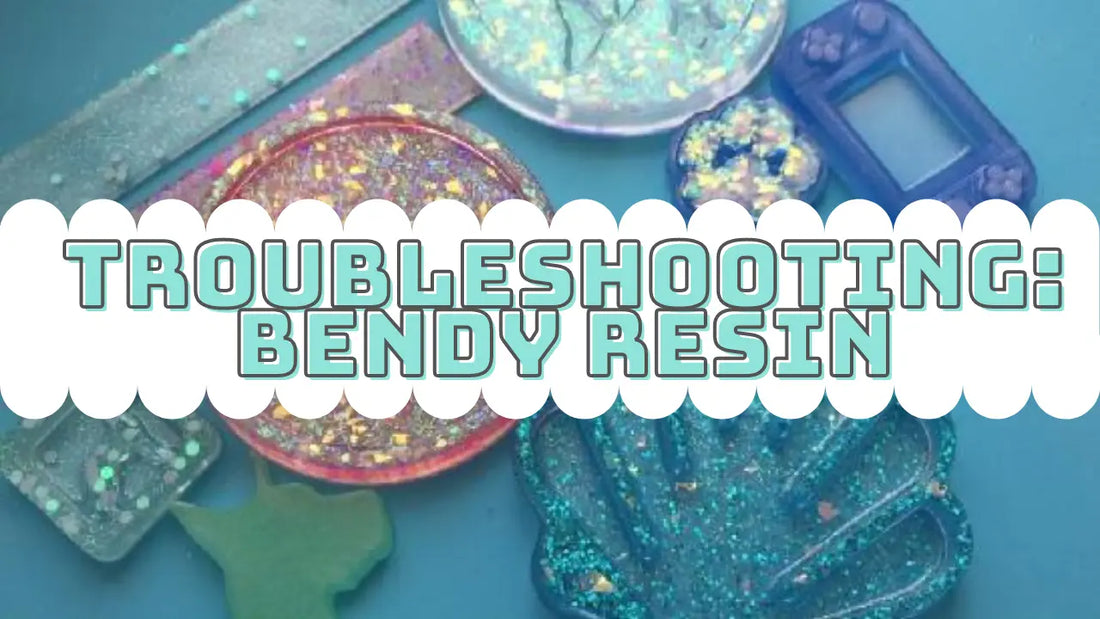
Why is my resin bendy?
Share
This blog post answers the following questions:
- Why is my resin bendy?
- Why is my resin not curing?
- Why did my resin not harden?
- Why is my resin still soft?
- Is resin supposed to be bendy?
Both Epoxy resin and UV resin are covered. I will be going through the reasons for Epoxy Resin first, followed by possible solutions, then with the reasons for UV Resin and again followed by possible solutions. I will finally go through some benefits of working with bendy resin.
Epoxy Resin: Possible reasons for bendy resin
Reason 1: Resin type
Firstly, make sure that the resin you are using actually cures to hard. There are some resin types that are specifically designed to remain soft.
Reason 2: Expired or old resin
Check if your resin is old/expired. If it's gone yellow it is expired. Always store your resin in a cool, dark, dry, area.
Reason 3: Mixing ratio
An incorrect mix ratio will result in uncured or bendy resin. It's very important to follow your resin brand's instructions as precisely as possible. Check if the instructions state to mix by weight or by volume as this will make a difference.
I personally like mixing resin in a silicone measuring cup, and for example for 1:1 epoxy resin I fill up to 20 ml of part A and then up to 40 ml of part B. That way I avoid the missing residue of resin resulting from measuring the hardener and the resin in separate measuring cups (and risking not having exactly equal parts of the resin in the final mixing cup).
Reason 4: Insufficient mixing
You need to mix the resin for at least 3-5 minutes. Always refer to instructions just in case a longer mixing time is required by the brand that you are using.
I also like to follow this rule if I'm adding color to my resin. When adding pigments or dyes, you need to ensure that it is thoroughly mixed in, because if it's not, it may be a cause for the resin to not equally cure.
Reason 5: Curing time
You may just need to wait longer for the resin to fully cure. Again you need to refer to to your resin brand's instructions for this as one brand will vary from another. Normally the resin will cure to a smooth non-sticky stage within 24 hours but will then require additional day/s to fully cure.
Keep in mind that the weather/room temperature affects the curing time. Resin builds heat when it starts to cure and if you are working in a cold room, it will take the mixed resin longer to reach the required curing temperature stage (or it might not be able to reach it at all). Also, if your resin has been stored in a cold area, you may want to give it a warm bath before using it.
Reason 6: Layer depth & Resin type
Check that the resin brand you are using is suitable for your project. There are different resin brands in the market that cater for different needs. Some resin brands are not suitable to use for thin layered resin projects. If you are working with thin layers of resin, it's best to check the details of the resin brand you are using as some will require a minimum depth amount to ensure a full cure (i.e. resin which is not bendy).
Reason 7: Dyes & Pigments
If you are adding color, be careful not to add too much. Adding too much color can affect the resin's mixture balance and as a result the resin will not cure well. Always add a little at a time. It's easier to add more if needed rather than the other way round.
Also, as mentioned earlier, make sure to mix in the color thoroughly. For best results mix for at least 3 minutes after adding the pigment/dye.
How can bendy Epoxy Resin be fixed?
Depending on the issue causing the resin to be bendy, you might be able to salvage your resin piece. If it's just a matter of not waiting enough time for the resin to cure, leave your resin to cure for a few more days.
Otherwise, if it's a case of mixing the resin incorrectly, or adding too much color, unfortunately there is no way to fix it. A possible solution for the latter two issues can be to add a reinforcement for support at the back of your resin piece, like a bezel or pour another layer.
UV Resin: Possible reasons for bendy resin
Reason 1: Incorrect mold
If you are working with UV resin, keep in mind that not all molds are suitable to use with UV resin. The basic guideline is that UV light needs to pass through the mold for UV resin use. If you are unsure whether your mold can be used for UV resin, you can ask your mold maker.
At worst cases, using unsuitable molds for UV resin will result in uncured and sticky resin.
Reason 2: Curing time
A common mistake is not curing the UV resin for enough time. This is very common among beginners to UV resin because UV resin will cure hard to the touch right away when exposed to UV light, but it takes much longer for the inside to fully cure.
What I like to do is cure the resin once under the UV lamp, and then flip over the mold to cure another time from the other end. I repeat this process for another 3/4 times. Then I place the mold in a windowsill which will get a few hours of sun during the day and let it cure for another 2-3 days. I avoid putting the resin outside because of dust, but if you have an available clean area, direct sunlight works best and quicker.
If your sun exposure is limited or weak, cure the resin under the UV lamp as much as needed.
Reason 3: Resin type
Make sure that the resin you are using actually cures to hard. There are some resin types that are specifically designed to remain soft.
Reason 4: Dyes & Pigments
If you are adding color, be careful not to add too much and make sure that you are mixing it in well into the UV resin. Mix for a minimum of 3 minutes.
How can bendy UV Resin be fixed?
It depends on the issue causing the bendy UV resin. If it's a case of using soft UV resin or the color was not sufficiently mixed, I'm afraid it's not possible to fix it.
If the incorrect mold was used, try getting the resin out of the mold (if at all possible) and cure it outside of the mold.
If the UV resin just needs more curing time, try following the tips I mention in Reason 2 above.
Using the bendy resin stage to your advantage
As many resin crafters do, you can use the bendy resin stage to your benefit. Some ideas are:
- You can add your findings or drill holes into your resin when the resin charm is still bendy. This will take much less effort and time if done correctly. If you will be attempting this for the first time, try experimenting on some pieces from the 'projects gone wrong' pile.
- It's easier to clean the edges or remove excess resin. Some resin crafters like to cut the edges off, and this can only be done when the resin is still bendy.
- On a more experienced and adventurous side, some resin artists use this stage to bend their resin piece into a final shape that they want. For example turning a flat shape into bowls or dishes.
